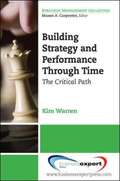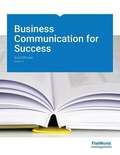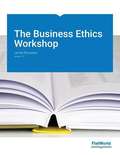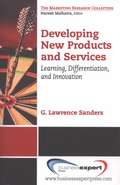- Table View
- List View
Advanced Business Law and the Legal Environment
by Don Mayer Daniel M. Warner George J. Siedel Jethro K. LiebermanMayer, Warner, Siedel and Lieberman's Advanced Business Law and the Legal Environment is an up-to-date textbook with coverage of legal and regulatory issues that are more technical than the topics in the authors' Foundations of Business Law and the Legal Environment. Appropriate for students who have already taken an introductory Legal Environment or Business Law course, the text is organized to permit instructors to tailor the materials to their particular approach. The authors take special care to engage students by relating law to everyday events with which they are already familiar with their clear, concise and readable style. Advanced Business Law and the Legal Environment provides students with context and essential legal concepts relating to the Uniform Commercial Code and various aspects of property law. The text provides the vocabulary and legal savvy necessary for business people to talk in an educated way to their customers, employees, suppliers, and other stakeholders -- and to their own lawyers. With Advanced Business Law and the Legal Environment, the authors have created a text that not only has both case summaries and excerpted cases, but one that you can easily customize by deleting chapters, reordering the content, adding your own material, and even editing at the line level with Flat World's easy-to-use MIYO (Make It Your Own) Platform.
American Government and Politics in the Information Age
by David L. Paletz Diana Owen Timothy E. CookAmerican Government and Politics in the Information Age by Paletz, Owen, and Cook, is a comprehensive introduction to the vital subject of American government and politics. It is a comprehensive introduction to American politics and government; it covers all the basics. The text: * introduces the intricacies of the Constitution, the complexities of federalism, the meanings of civil liberties, and the conflicts over civil rights; * explains how people are socialized to politics, acquire and express opinions, and participate in political life; * describes interest groups, political parties, and elections--the intermediaries that link people to government and politics; * details the branches of government and how they operate; * shows how policies are made and affect people's lives.
The Basics of General, Organic, and Biological Chemistry
by David W. Ball John W. Hill Rhonda J. J. ScottThe Basics of General, Organic, and Biological Chemistry by David W. Ball, John W. Hill, and Rhonda J. Scott is a new textbook offering for the one-semester GOB Chemistry course. The authors designed this book from the ground up to meet the needs of a one-semester course. It is 20 chapters in length and approximately 350-400 pages; just the right breadth and depth for instructors to teach and students to grasp. In addition, The Basics of General, Organic, and Biological Chemistry is written not by one chemist, but THREE chemistry professors with specific, complimentary research and teaching areas. David W. Ball's specialty is physical chemistry, John W. Hill's is organic chemistry, and finally, Rhonda J. Scott's background is in enzyme and peptide chemistry. These three authors have the expertise to identify and present only the most important material for students to learn in the GOB Chemistry course. These experienced authors have ensured their text has ample in-text examples, and "Test Yourself" questions following the examples so students can immediately check their comprehension. The end-of-chapter exercises will be paired, with one answered in the back of the text so homework can easily be assigned and self-checked.
Building Strategy and Performance
by Kim WarrenThe fundamental challenge facing business leaders is to drive performance into the future--the dynamics of strategy. To tackle this effectively, they need a clear understanding of what causes performance to improve or deteriorate and what power they have to change this trajectory for the better. Without this understanding, they risk making poor choices about their future--failing to exploit promising opportunities, pursuing unachievable aims, or falling victim to competitive and other threats. Building Strategy and Performance Through Time sets the agenda for building business strategy in powerful, actionable, and accessible terms. It gives executives clear frameworks for answering three fundamental questions: * Why is our business performance following its current path? * Where is it going if we carry on as we are? * How can we design a robust strategy to transform this future? The existing strategy tools most widely used help guide management's choices about where to compete--which customers to serve, with what products and services, and how to deliver those products and services to those customers effectively and profitably. While this choice is important, it is not often changed in any fundamental way; having found a reasonably strong and profitable position on these issues, few firms will, or should, set off in a new direction. But there is still much to be done to deliver that strategy, powerfully and sustainably over time. Many decisions need to be made, continually and holistically, across all functions of the business and adapted as conditions change from month to month and year to year. Pricing, product development, marketing, hiring, service levels, and other decisions cannot be made in isolation but must take into account other choices being made, elsewhere and at different times. Building Strategy and Performance Through Time explains a reliable, practical method, known as strategy dynamics, that creates a living picture of how an enterprise actually works and delivers performance. This picture shows exactly where the levers are that management controls and how to choose what to do, when, and how much, to accomplish your specific goals. It shows, too, how the same approach can be used to defeat competitors, cope with other outside forces, and keep delivering performance.
Business Communication for Success
by Scott McleanThis book is suited for Business Communication courses, but is also appropriate for Business English, Business Presentation, Professional Communication courses. Scott McLean brings his authoring expertise to this new communications textbook. Scott has authored textbooks in the areas of Speech Communication, Interpersonal Communication and Public Speaking. Business Communications for Success benefits from Scott's extensive understanding of how students learn the art of effective communication. Students are provided ample opportunity to engage with the concepts, vocabulary and models covered in the text, including role-playing exercises, journal writings, case studies, small-group activities, games, and self-assessment activities.
Business Communication for Success
by Scott McleanThis book is suited for Business Communication courses, but is also appropriate for Business English, Business Presentation, Professional Communication courses. Scott McLean brings his authoring expertise to this new communications textbook. Scott has authored textbooks in the areas of Speech Communication, Interpersonal Communication and Public Speaking. Business Communications for Success benefits from Scott's extensive understanding of how students learn the art of effective communication. Students are provided ample opportunity to engage with the concepts, vocabulary and models covered in the text, including role-playing exercises, journal writings, case studies, small-group activities, games, and self-assessment activities.
Business Communication for Success (Canadian Edition)
by Scott Mclean Murray MomanThis book is suited for Business Communication courses taught in Canada, but is also appropriate for Business English, Business Presentation, Professional Communication courses. The Canadian version was adapted by Murray Moman to include proper spelling and grammar for the Northern Territories. In addition, the examples are taken from Canadian companies and situations so students in Canada can truly relate to the textbook content.
Business English for Success
by Scott McleanBusiness English for Success is a creative solution to a common challenge across Business Communication courses: Business English or Business Presentations? Some classes place an equal emphasis on oral and written communication. If that's the case for you check out our free online text Business Communication for Success. If, however, your class places the emphasis squarely on written communication and writing proficiency, then Business English for Success is for you. Business English for Success provides instruction in steps, builds writing, reading, and critical thinking, and combines comprehensive grammar review with an introduction to paragraph writing and composition. This step-by-step approach provides a clear path to student-centered learning. A wide range of writing levels and abilities are addressed, helping each student prepare for the next writing or university course.
The Business Ethics Workshop v 1.0
by James BrusseauOn a good day in the business ethics classroom discussion charges forward; students have read the assigned case study, they’re engaged by the conflict and want to work through it. Then, there’s a bad day: students didn’t bother to do the reading and the hour sags listlessly. The key to going the first way is case studies that students want to read, and The Business Ethics Workshop by James Brusseau provides them with reality and engagement. Reality: No stilted and contrived stories about Steve Smith and Jane Jones. Excerpts from blogs and newspapers bring the weight—and provocation—of the world as it’s actually happening to the classroom.
The Business Ethics Workshop v 1.0
by James BrusseauOn a good day in the business ethics classroom discussion charges forward; students have read the assigned case study, they're engaged by the conflict and want to work through it. Then, there's a bad day: students didn't bother to do the reading and the hour sags listlessly. The key to going the first way is case studies that students want to read, and The Business Ethics Workshop by James Brusseau provides them with reality and engagement. Reality: No stilted and contrived stories about Steve Smith and Jane Jones. Excerpts from blogs and newspapers bring the weight--and provocation--of the world as it's actually happening to the classroom.
Business Information Systems: Design an App for That
by Raymond D. Frost Jacqueline C. Pike Lauren N. Kenyo Sarah E. PelsStudents in introductory Management Information Systems (MIS) courses often ask what a career in MIS looks like. Lacking a clear vision, they make their own assumptions. Often they assume the career involves programming with little human interaction. That MIS is a technical field could not be further from the truth. MIS job descriptions typically require candidates to be able to collaborate, communicate, analyze needs and gather requirements. They also list the need for excellent written and communication skills. In other words, MIS workers are constantly interacting with other people both inside and outside the organization. They are coming up with creative solutions to business problems. Business Information Systems by Frost, Pike, Kenyo and Pels is designed to help students get a feel for what a career in MIS would be like. The authors' students report that they learn more about information systems from their internships than from their IS courses. Consequently, they designed a book that looks very much like an internship--an introduction to the field followed by a substantial project. The authors begin Unit 1 by introducing the information systems landscape. The unit kicks off with a discussion of all the usual suspects: the information systems triangle, the systems development life cycle, transaction systems (ERP, SCM, CRM), collaboration systems, and business intelligence systems. Other aspects of the landscape such as usability, outsourcing, database concepts and so forth are introduced throughout a chapter in unit 2 where they fit in naturally with the flow of the project. Unit 2 is the substantial project which runs over a number of chapters. Students will plan, build, and develop a proposal for an iPhone application. They will develop a very realistic mockup. They also build a website to help market and support the app. Students are engaged because the project is fun and feels real. However, they are simultaneously learning business concepts and MIS skills. With Designing Information Systems, even as freshmen, you can give your students an experience that emulates MIS in operation. Business Information Systems: Design an App for That by Frost, Pike, Kenyo and Pels is a text that will help students learn Information Systems by doing Management Information Systems. Request a desk copy or examine the book online now to see how this text might work in your course or department.
Business Law and the Legal Environment
by Don Mayer Daniel M. Warner George J. Siedel Jethro K. LiebermanMayer, Warner, Siedel and Lieberman's Business Law and the Legal Environment is an up-to-date textbook with comprehensive coverage of legal and regulatory issues — and organized to permit instructors to tailor the materials to their particular approach. The authors take special care to engage students by relating law to everyday events with which they are already familiar with their clear, concise and readable style. Business Law and the Legal Environment provides students with context and essential concepts across the entire range of legal issues with which managers and business executives must grapple. The texts provide the vocabulary and legal acumen necessary for business people to talk in an educated way to their customers, employees, suppliers, government officials — and to their own lawyers.
Business Law and the Legal Environment: Executive MBA Edition
by Don Mayer Daniel M. Warner George J. Siedel Jethro K. LiebermanMayer, Warner, Siedel and Lieberman's Business Law and the Legal Environment (EMBA Edition) is an up-to-date textbook especially designed for students in EMBA programs. The text is organized to permit instructors to tailor the materials to their particular approach. The authors take special care to engage students by relating law to everyday events with their clear, concise and readable style. After introductory chapters covering the legal environment of business, Business Law and the Legal Environment (EMBA Edition) provides students with context and essential legal concepts relating to contracts, products liability, agency law, partnerships, corporations and government regulation. The text provides the vocabulary and legal savvy they will need to talk in an educated way to customers, suppliers, employees, creditors, shareholders, government regulators and other stakeholders — and to their own lawyers. With Business Law and the Legal Environment (EMBA Edition), the authors have created a text that not only has both case summaries and excerpted cases, but one that you can easily customize by deleting chapters, reordering the content, adding your own material, and even editing at the line level with Flat World's easy-to-use MIYO (Make It Your Own) Platform. The free online version of the text includes embedded links to law-related videos at YouTube and other online sites for easy access by students and instructors.
Business Law and the Legal Environment: Master of Accountancy Edition
by Don Mayer Daniel M. Warner George J. Siedel Jethro K. LiebermanMayer, Warner, Siedel and Lieberman's Business Law and the Legal Environment: MAcc Edition is an up-to-date textbook designed for students in Master of Accounting programs. The text is organized to permit instructors to tailor the materials to their particular approach. The authors take special care to engage students by relating law to everyday events with their clear, concise and readable style. After introductory chapters covering the legal environment of business, Business Law and the Legal Environment: MAcc Edition provides students with context and essential legal concepts that accounting professionals must understand, including contracts, sales, commercial paper, debtors and creditors rights, intellectual property, agency law, partnerships, corporations, and regulatory law. The text provides the vocabulary and legal savvy students will need when working in the accounting function or on engagements. With Business Law and the Legal Environment: MAcc Edition, the authors have created a text that not only has both case summaries and excerpted cases, but one that you can easily customize by deleting chapters, reordering the content, adding your own material, and even editing at the line level with Flat World's easy-to-use MIYO (Make It Your Own) Platform. The free online version of the text includes embedded links to law-related videos at YouTube and other online sites for easy access by students and instructors.
Business Law and the Legal Environment
by Don Mayer Daniel M. Warner George J. Siedel Jethro K. LiebermanMayer, Warner, Siedel and Lieberman's Business Law and the Legal Environment is an up-to-date textbook with comprehensive coverage of legal and regulatory issues -- and organized to permit instructors to tailor the materials to their particular approach. The authors take special care to engage students by relating law to everyday events with which they are already familiar with their clear, concise and readable style. Business Law and the Legal Environment provides students with context and essential concepts across the entire range of legal issues with which managers and business executives must grapple. The texts provide the vocabulary and legal acumen necessary for business people to talk in an educated way to their customers, employees, suppliers, government officials -- and to their own lawyers.
College Success
by Bruce Beiderwell Linda Tse Thomas J. Lochhaas Nicholas B. DekanterCollege Success takes a fresh look at what it means, in today's world, with today's students, to be successful in college. Although many of the topics included--from study skills to personal health, from test-taking to managing time and money--will look familiar to those who have used student success texts that have been around for many editions, College Success takes a new approach. The focus is on realistic, practical tools for the students who need them. This is a book designed, frankly, for students who may have difficulty with traditional college texts. The style is direct and to the point. Information is presented concisely and as simply as possible. This is not a weighty tome that discusses student success--this is a manual for doing it. College student demographics have changed considerably in recent decades. More than a third of all students enroll not directly from high school but after a delay of some years. More students are working and have families. More students come from varied ethnic and cultural backgrounds. More students are the first in their family to attend college. More students have grown up with electronic media and now read and think in ways different from the previous generation. With these and so many other cultural changes, more students are not well prepared for a college education with the study skills and life skills they need to become successful students. For each student to get the most out of College Success and their college experience they must understand who they are as it relates to college. To that end, in every chapter students explore themselves, because success starts with recognizing your own strengths and weaknesses. Students make their own goals based on this self-assessment, determining what success in college really means for them as individuals. Interactive activities then help students learn the choices available to them and the possibilities for improving their skills. Skills are presented in step-by-step processes, tips for success in manageable highlighted displays. Most important, students always see the value of what they are reading--and how they can begin to apply it immediately in their own lives. College Success is intended for use in Freshmen Orientation, Study Skills or Student Success courses. A 2009 study revealed that currently nationwide, 34% of college freshmen do not return to their college for their sophomore year. This book is designed to help change that.
Communication in the Real World
by Richard G. Jones Jr.Communication in the Real World: An Introduction to Communication Studies by Richard G. Jones, Jr. overviews the time-tested conceptual foundations of the field, while incorporating the latest research and cutting-edge applications of these basics. Each chapter will include timely, concrete, and real-life examples of communication concepts in action. A key feature of this book is the integration of content regarding diversity and organizational communication in each chapter through examples and/or discrete sub-sections. Discussions of diversity are not relegated to feature boxes. Also integrated into the content are examples that are inclusive in terms of race, gender, sexuality, ability, age, marital status, religion, and other diverse identity characteristics.
Criminal Law
by Lisa StormIf you ask Lisa Storm, she'll say, "Let's face it, legal textbooks can be dry." She'll also tell you what you already know, "This is unfortunate because law, especially criminal law, is an intrinsically compelling topic." That is why she employs the "applied approach" (and takes it to a new level) to hold your students' attention and keep them alert. Criminal Law employs a variety of instructional techniques which will engage your students from start to finish. First, every chapter contains embedded videos, ethical scenarios, charts, diagrams, and/or tables to demonstrate the legal concepts and examples provided. These enhancements break up the text and also appeal to various learning styles.
Developing New Products and Services
by G. Lawrence SandersThe focus of the book is on the up-front activities and ideas for new product and service development. A central theme of this book is that there is, or should be, a constant struggle going on in every organization, business, and system between delivering feature-rich versions of products and services using extravagant engineering and delivering low-cost versions of products and services using frugal engineering. Delivering innovative products is accomplished by an endless cycle of business planning, creative and innovative insight, and learning-about and learning-by-doing activities. A number of powerful concepts and tools are presented in the book to facilitate new product development. For example, three templates are presented that facilitate new product and service development. The FAD (features, attributes, and design) template is used to identify the features and attributes that can be used for product and service differentiation. The Ten-Ten planning process contains two templates: an Organizational and Industry Analysis template and the Business Plan Overview template. These two templates coupled with the FAD template can be used to develop a full-blown business plan. Entrepreneurship, technology and product life cycles, product and service versioning, product line optimization, creativity, lock-in real options, business valuation, and project management topics are also covered.
Developing New Products and Services
by G. Lawrence SandersThe focus of the book is on the up-front activities and ideas for new product and service development. A central theme of this book is that there is, or should be, a constant struggle going on in every organization, business, and system between delivering feature-rich versions of products and services using extravagant engineering and delivering low-cost versions of products and services using frugal engineering. Delivering innovative products is accomplished by an endless cycle of business planning, creative and innovative insight, and learning-about and learning-by-doing activities. A number of powerful concepts and tools are presented in the book to facilitate new product development. For example, three templates are presented that facilitate new product and service development. The FAD (features, attributes, and design) template is used to identify the features and attributes that can be used for product and service differentiation. The Ten-Ten planning process contains two templates: an Organizational and Industry Analysis template and the Business Plan Overview template. These two templates coupled with the FAD template can be used to develop a full-blown business plan. Entrepreneurship, technology and product life cycles, product and service versioning, product line optimization, creativity, lock-in real options, business valuation, and project management topics are also covered.
Economics: Theory Through Applications
by Russell Cooper A. Andrew JohnThis textbook, Economics: Theory Through Applications, centers around student needs and expectations through two premises: ... Students are motivated to study economics if they see that it relates to their own lives. ... Students learn best from an inductive approach, in which they are first confronted with a problem, and then led through the process of solving that problem. Many books claim to present economics in a way that is digestible for students; Russell and Andrew have truly created one from scratch. This textbook will assist you in increasing students' economic literacy both by developing their aptitude for economic thinking and by presenting key insights about economics that every educated individual should know.
Elementary Algebra
by John ReddenIt is essential to lay a solid foundation in mathematics if a student is to be competitive in today's global market. The importance of algebra, in particular, cannot be overstated as it is the basis of all mathematical modeling used in applications found in all disciplines. Traditionally, the study of algebra is separated into a two parts, Elementary and Intermediate Algebra. This textbook by John Redden, Elementary Algebra, is the first part written in a clear and concise manner, making no assumption of prior algebra experience. It carefully guides students from the basics to the more advanced techniques required to be successful in the next course.
eMarketing: The Essential Guide to Online Marketing
by Rob Stokes the Minds of QuirkeMarketing: The Essential Guide to Online Marketing by Rob Stokes, a marketing guru and CEO of Quirk eMarketing, Sarah Blake, and his team of QuirkStars, consolidates 11 years of real marketing experience doing online marketing at Quirk into a full length textbook that draws on both academic theory and practical experience. It is intended for third and fourth year marketing students, this textbook covers all of the important aspects of online marketing, including chapters on each of the following areas: * Search Engine Marketing * Affiliate Marketing * Web Analytics and Conversion Optimisation * Web Development * Online Copywriting * Online Advertising * WebPR * Online Reputation Management * Pay Per Click Advertising * Viral Marketing * Social Media Marketing * Search Engine Optimisation * eMarketing Strategy * Market Research * Mobile Marketing * Crowdsourcing * Customer Relationship Management It also features a glossary and index as well as summaries, learning objectives and discussion points for each chapter. This eMarketing textbook offers students information that is highly applicable with examples to which they can easily relate. It is a must-have guide for each and every undergraduate and post-graduate marketing student as well as anyone working in the digital or traditional marketing sphere.
Essentials of Geographic Information Systems
by Jonathan Campbell Michael ShinEssentials of Geographic Information Systems integrates key concepts behind the technology with practical concerns and real-world applications. Recognizing that many potential GIS users are non-specialists or may only need a few maps, this book is designed to be accessible, pragmatic and concise. Essentials of Geographic Information Systems also illustrates how GIS is used to ask questions, inform choices and guide policy. From the melting of the polar ice caps to privacy issues associated with mapping, this book provides a gentle, yet substantive, introduction to the use and application of digital maps, mapping and GIS.
Essentials of Nutrition
by Maureen Zimmerman Beth SnowEssentials of Nutrition: A Functional Approach, by Zimmerman and Snow is a textbook aimed at non-majors for the nutrition course. With this text your students will examine some of the popular myths about nutrition and will develop a foundation for making smart dietary choices and to debunk these common nutrition myths. As students learn about the role of nutrition in optimal health, they will learn about dietary nutrients and toxicants. A sampling of topics covered include macro- and micronutrient needs; determining individual nutrient and caloric needs; digestion and absorption; nutritional needs throughout the various stages of human development; and current food issues, sustainability concerns, including food safety.





